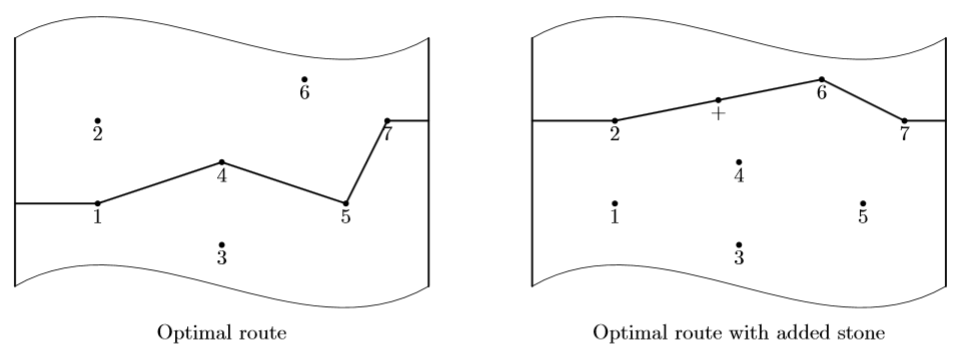 Рабочее место участника
Рабочее место участника
| Выбрать соревнование | Задачи | Послать решение | Результаты проверки | Статистика по задачам | Вопросы и ответы | Результаты соревнования | Состояние сервера | Изменить данные | Управление командой | Помощь |
 Задачи
Задачи
2265. Froggy Ford Кратчайшие пути из одной вершины
Кратчайшие пути из одной вершиныОлимпиадные задачи на английском языке

| 23/12/2015 | Задачи NEERC 2015 (F) |
Ограничения: время – 2s/4s, память – 256MiB Ввод: froggy.in или стандартный ввод Вывод: froggy.out или стандартный вывод 
Послать решение Blockly Посылки Темы Где Обсудить (0)
Fiona designs a new computer game Froggy Ford. In this game,
a player helps a frog to cross a river using stone fords.
Frog leaps from the river's shore to the first stone ford,
than to the second one and so on, until it reaches the other shore.
Unfortunately, frog is pretty weak and its leap distance is
quite limited. Thus, a player should choose the optimal route –
the route that minimizes the largest leap required to traverse the route.

Fiona thinks that this game is not challenging enough, so she plans
to add a possibility to place a new stone in the river. She asks you
to write a program that determines such a location of the new stone that
minimizes the largest leap required to traverse the optimal route.
Input
The first line of the input file contains two integers `w` –
the width of the river and `n` – the number of stones in it
(`1\ ≤\ w\ ≤\ 10^9`, `0\ ≤\ n\ ≤\ 1000`).
Each of the following `n` lines contains two integers `x_i`, `y_i` –
the coordinates of the stones (`0\ <\ x_i\ <\ w`, `-10^{9}\ ≤\ y_i\ ≤\ 10^9`).
Coordinates of all stones are distinct.
River shores have coordinates `x=0` and `x=w`.
Output
Write to the output file two real numbers `x_+` and `y_+`
(`0\ <\ x_+\ <\ w`, `-10^{9}\ ≤\ y_+\ ≤\ 10^9`) –
the coordinates of the stone to add. This stone shall minimize
the largest leap required to traverse the optimal route.
If a new stone cannot provide any improvement to the optimal route,
then an arbitrary pair of `x_+` and `y_+`
satisfying the constraints can be written, even coinciding with one of the existing stones.
Your answer shall be precise up to three digits after the decimal point.
Sample Input
10 7 2 2 2 4 5 1 5 3 8 2 7 5 9 4
Sample Output
4.5 4.5
 Начало
Начало